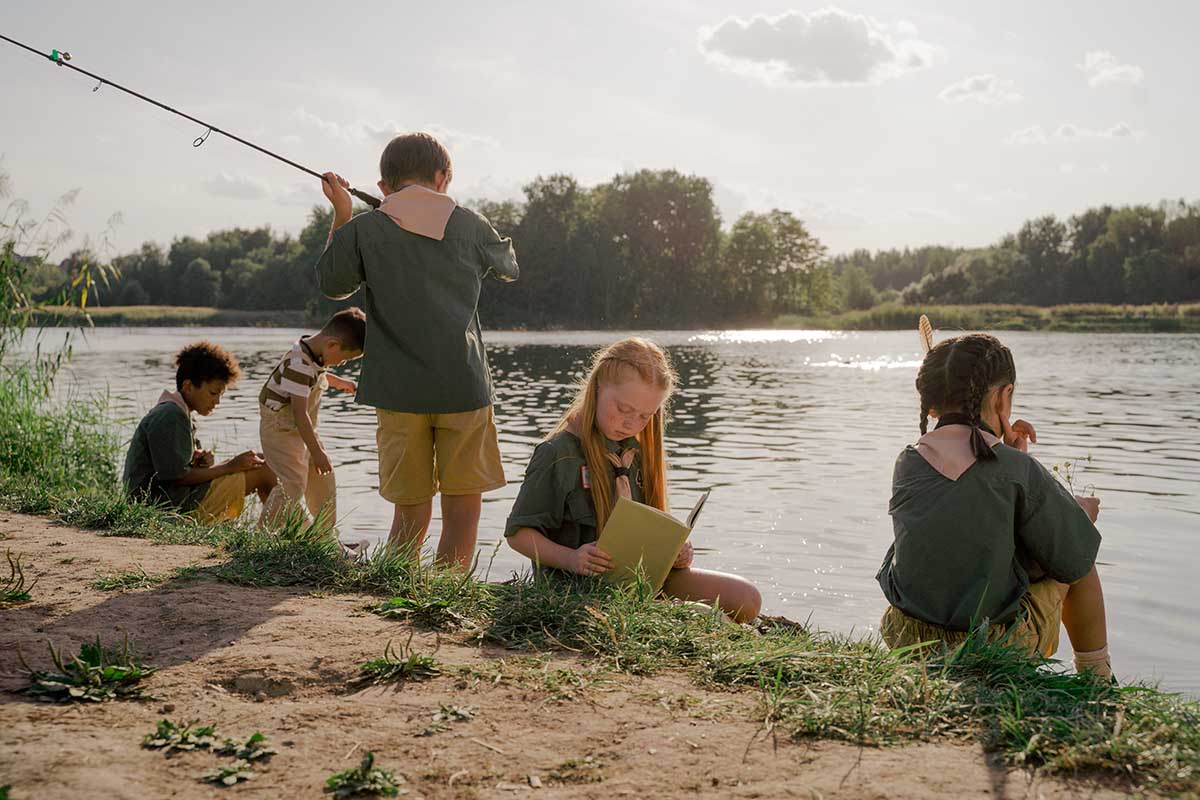How To Pick A Fishing Rod For Children
Building an angling starter kit for your children is necessary when teaching them to fish. Shared tackle boxes, hooks, and lures are acceptable, but they need their own fishing rods.
It should be compact, lighter, and equipped with kid-friendly features to make it simple for young children.
Therefore, buy one based on their height and level of expertise to make sure your kids enjoy fishing rather than getting frustrated using adult poles. The following essential characteristics should be considered in addition to length when selecting a fishing rod for children.
Fishing Rods For Kids – What to Look For
Length of the rod
The length of the rod is an important consideration when purchasing a pole for your children. The child’s size and the weight of the angling pole increase with height.
To preserve your child’s casting skills, stay away from very short rods.
The pole should be about the same height as they are. Children find it challenging to maneuver longer poles, which may lower their fishing confidence.
Approximately 3-4 feet is the length of a starter rod that a 4-year-old child can comfortably hold for precise casting. Consider purchasing longer poles as your child becomes more adept at casting accurately.
The following rule will assist you in selecting the rod according to the child’s age:
- 3-5 years old- 2-3 feet long rod;
- 6-9 years old- 4-5 feet long rod;
- 10 years and above- Over 5 feet long rod (by the age and height of your child.)
If your child has good casting and reeling skills, you can choose longer rods around 6-7 feet.
Reel style
You can choose between closed-faced (also known as “push-button” or “spincast reels”) and open-faced reels (spinning reels). Beginner fishing rods work best with these two types.
Spincast reels are a good place to start because they have a button that releases the line from the spool.
Kids can cast with ease because the line is kept tangle-free as a result. You can purchase the reel separately, or a reel and rod set made specifically for children.
You might want to think about one that features well-known children’s cartoons because it gives their fishing gear some flair.
Choose spinning reels if your child is older than 7 or has some experience fishing. The open-faced reels take more practice to use but will better prepare your child for fishing with adults.
They are also the best for saltwater fishing because they are less likely to develop mechanical problems and are simpler to clean.
Rod’s material
The rod’s durability depends on the material used to make it. To avoid replacing the rod after every trip, choose a material that can withstand accidental drops and foot traffic from your children.
You can choose a rod made of fiberglass, graphite, or composite blends because they are light and durable enough to withstand use by children.
Fiberglass rods
The best starter pole for your children is made of fiberglass. As your child learns to cast or reel in, they can withstand erratic movements because they are durable and affordable.
The disadvantage of fiberglass rods is that they are not very sensitive, which makes it difficult for young children to quickly identify a bite.
Graphite rods
For older children who have previous fishing experience, graphite rods are a good alternative. Due to their high sensitivity, it is simpler to spot small bites.
Additionally, graphite rods are strong, lightweight, and flexible. The disadvantages of these materials include their higher cost compared to other types and their fragility when not handled carefully.
Composite rods
Composite rods are composed of two or more materials, such as a mixture of fiberglass and graphite or glass and epoxy. Based on a combination of materials, the rods are typically thin, bendable, and strong. Compared to graphite rods, they are also less expensive and perform well without breaking.
Weight
The material used significantly impacts the rod’s weight. Plastic is typically the lightest material, but it is brittle and not recommended for children.
Consider using fiberglass or composite rods because they are strong and lightweight. However, it’s crucial to check the rod’s precise weight under specs before placing an order to make sure your child can handle it without discomfort.
Additional child-friendly angling accessories
The best option would be to take into account a fishing rod with extra gear that makes fishing simple and enjoyable for your kid. For instance, some fishing rod and reel sets come with snap swivels, extra hooks, casting plugs, and bobbers that are useful for learning. You can purchase a separate rod and reel to add the safety equipment to the set-up.
Tangle free rods
It’s not a cruel task to teach your children to fish, but if you don’t get them the right equipment, they’ll tangle the line. Think about a rod with a line inside the shaft.
These are excellent for toddlers because they never tangle, no matter what.
What else can help you get the best fishing rod for your kid?
In addition to the qualities mentioned above, you should consider the following important factors when selecting a fishing rod for your children:
Fishing location
Are you going to fish from a boat from the bank of a lake, stream, or fishing pond? Use stronger rods if you’re trolling from a boat instead of casting into a small lake or pond.
Your kid’s fishing experience
You might want to think about exposing your older kids to fly rods rather than your younger ones if they have some prior fishing experience. Experience determines not only the type but also the ideal length of the rod. You could also choose larger open-faced reels because they are already better at managing the line while casting and reeling in the catch.
Your child’s age
Older kids can begin using fly rods or spinning reels with open faces with your guidance. Children who are older than toddlers can more easily be introduced to fly rods. Therefore, spinning rods and closed reels should be used as a starting point when working with children between the ages of 2-4.
Summary
Finding the best angling rod and other necessary accessories is part of preparing your child for fishing. Always start by thinking about lightweight, shorter, and tangle-free rods with closed-faced reels made of durable material.
To get them ready for adult fishing, introduce your child to fly rods or open-faced spinning rods as they gain experience. In order to help your child recognize subtle bites as they gain experience, you might also want to think about graphite rods.





















